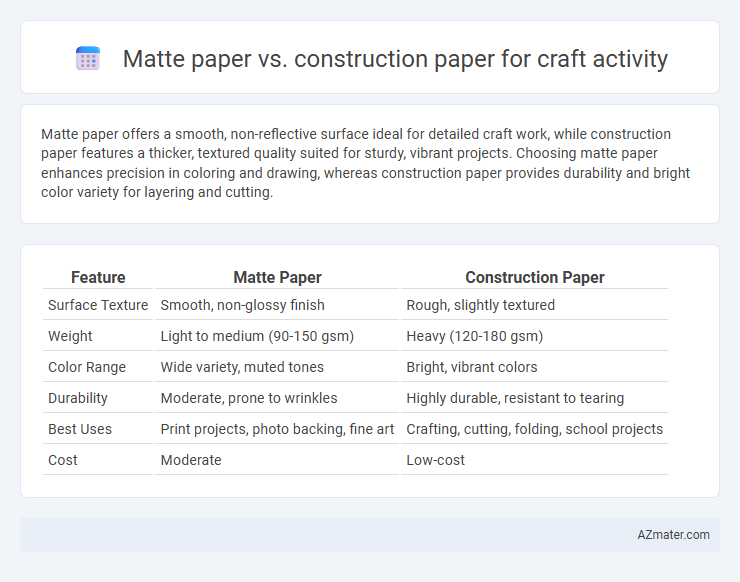Matte paper offers a smooth, non-reflective surface ideal for detailed craft work, while construction paper features a thicker, textured quality suited for sturdy, vibrant projects. Choosing matte paper enhances precision in coloring and drawing, whereas construction paper provides durability and bright color variety for layering and cutting.
Table of Comparison
| Feature | Matte Paper | Construction Paper |
|---|---|---|
| Surface Texture | Smooth, non-glossy finish | Rough, slightly textured |
| Weight | Light to medium (90-150 gsm) | Heavy (120-180 gsm) |
| Color Range | Wide variety, muted tones | Bright, vibrant colors |
| Durability | Moderate, prone to wrinkles | Highly durable, resistant to tearing |
| Best Uses | Print projects, photo backing, fine art | Crafting, cutting, folding, school projects |
| Cost | Moderate | Low-cost |
Introduction: Choosing the Right Paper for Crafts
Matte paper offers a smooth, non-reflective surface ideal for detailed drawings and vibrant color application in craft activities. Construction paper, known for its durability and bold colors, is perfect for cutting, folding, and collage projects commonly used in schools. Selecting between matte and construction paper depends on the craft's need for texture, color vibrancy, and structural integrity.
Understanding Matte Paper: Features and Uses
Matte paper features a non-reflective, smooth surface that enhances color depth and detail, making it ideal for detailed craft projects like scrapbooking or card making. Its sturdy texture resists smudging and fingerprints, providing durability for artwork that requires precision and a professional finish. Matte paper is versatile for various mediums including ink, watercolor, and pastels, offering consistent quality and a sophisticated appearance in craft activities.
What is Construction Paper? Properties and Benefits
Construction paper is a thick, coarse, and durable type of paper primarily used for art and craft projects, known for its bright colors and textured surface that enhances visual appeal. Its heavy weight and rigidity make it ideal for cutting, folding, and gluing, providing structural support in various craft activities. Construction paper is also absorbent, allowing for easy application of paints and markers while minimizing bleeding, making it a versatile material for creative expression.
Texture and Finish: Matte vs Construction Paper
Matte paper offers a smooth, non-reflective finish that enhances detailed drawing and vibrant color application, making it ideal for precision craft projects. Construction paper features a rougher, fibrous texture that provides durability and a tactile feel, preferred for hands-on activities like cutting, folding, and collage. The choice between matte and construction paper significantly affects the overall look and handling of craft creations due to their distinct surface qualities.
Color Vibrancy and Range Comparison
Matte paper offers a rich, smooth surface that enhances color vibrancy by reducing glare, making hues appear deeper and more saturated, ideal for detailed craft activities. Construction paper provides a broader range of bright, bold colors with a textured finish that appeals to hands-on projects but may result in slightly muted tones compared to matte finishes. Choosing between the two depends on the desired color intensity and the tactile feel required for the craft.
Durability for Craft Activities
Matte paper offers a smooth finish with moderate durability, suitable for detailed craft activities that require precision and surface uniformity. Construction paper is thicker and more robust, designed to withstand handling, folding, and layering, making it ideal for projects that demand higher durability and resilience. For long-lasting crafts or items exposed to wear, construction paper outperforms matte paper due to its sturdier fiber composition.
Ease of Cutting, Folding, and Shaping
Matte paper offers a smooth surface and moderate thickness that makes it easy to cut and fold precisely, ideal for detailed craft activities requiring sharp edges and clean lines. Construction paper is thicker and more textured, which can make cutting somewhat challenging but provides excellent durability for shaping and layering in more robust projects. Both types perform well, but matte paper excels in fine, intricate folds while construction paper withstands more handling and shaping without tearing.
Suitability for Drawing, Painting, and Adhesives
Matte paper offers a smooth, non-reflective surface ideal for detailed drawing and precise painting techniques, providing excellent color vibrancy and control. Construction paper, thicker and coarser, excels in adhesive applications, supporting glue and layering projects without warping but may absorb paint unevenly, making it less suitable for fine painting. Choosing between the two depends on whether the craft activity prioritizes detailed artistry or robust, adhesive-based assembly.
Project Ideas: Matte Paper vs Construction Paper
Matte paper offers a smooth, non-reflective surface ideal for detailed drawing, painting, and fine art projects, enhancing color vibrancy and precision. Construction paper's sturdy texture and bold colors make it perfect for cutting, folding, and collage crafts, especially suited for children's activities and 3D paper models. Both materials support diverse project ideas, with matte paper excelling in visual clarity and construction paper in tactile creativity and structural projects.
Cost-Effectiveness and Availability
Matte paper offers a cost-effective option for craft activities due to its affordability and widespread availability in stationary and art supply stores. Construction paper, while slightly more expensive, provides vibrant colors and thicker texture but may have limited availability in specialized colors or larger quantities. Choosing matte paper ensures budget-friendly crafting with easy access to a variety of sizes and finishes, making it ideal for bulk projects.

Infographic: Matte paper vs Construction paper for Craft activity
 azmater.com
azmater.com